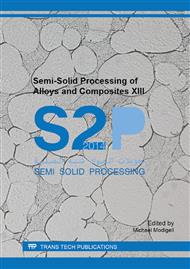p.294
p.302
p.312
p.318
p.325
p.332
p.340
p.347
p.355
Steels with High Temperature Carbides - New Possibilities for Semi-Solid State Processing
Abstract:
Semi-solid processing of steels is typically studied using high-alloy steels with higher carbon levels, as those offer a long freezing range which is favourable for conducting the process. The drawback to their application is their microstructure which typically consists of austenite grains embedded in ledeburitic network. This type of microstructure typically fails in brittle manner by fracturing along the interface of the hard network and ductile austenite grains. This is why a way was sought to altering or even inverting the configuration of the microstructure. Eventually, suitable steel chemistries were found which allow the inverted microstructure to be obtained. With regard to the high content of alloy additions, these steels have to be made by powder metallurgy methods. Five different steels of this kind were selected for the experimental programme. All contained high amounts of alloying elements and a large fraction of carbides. Their carbon content was taken into account as well, ranging from 0.55 to 3.4 %. Differences between the steels consisted in the levels of major alloying elements, namely chromium, vanadium, molybdenum, tungsten and cobalt. After suitable process parameters were found, semi-solid processing was used to prepare demonstration products. The transition through semi-solid state transformed the ferritic matrix to austenitic-martensitic one, in which the high-stability carbides were retained. The resulting microstructures were of unconventional nature where carbide particles were embedded in tough metal matrix. Their configuration was thus inverted in contrast to the ones typically obtained by semi-solid processing of tool steels.
Info:
Periodical:
Pages:
325-331
Citation:
Online since:
September 2014
Authors:
Permissions:
Share:
Citation:


